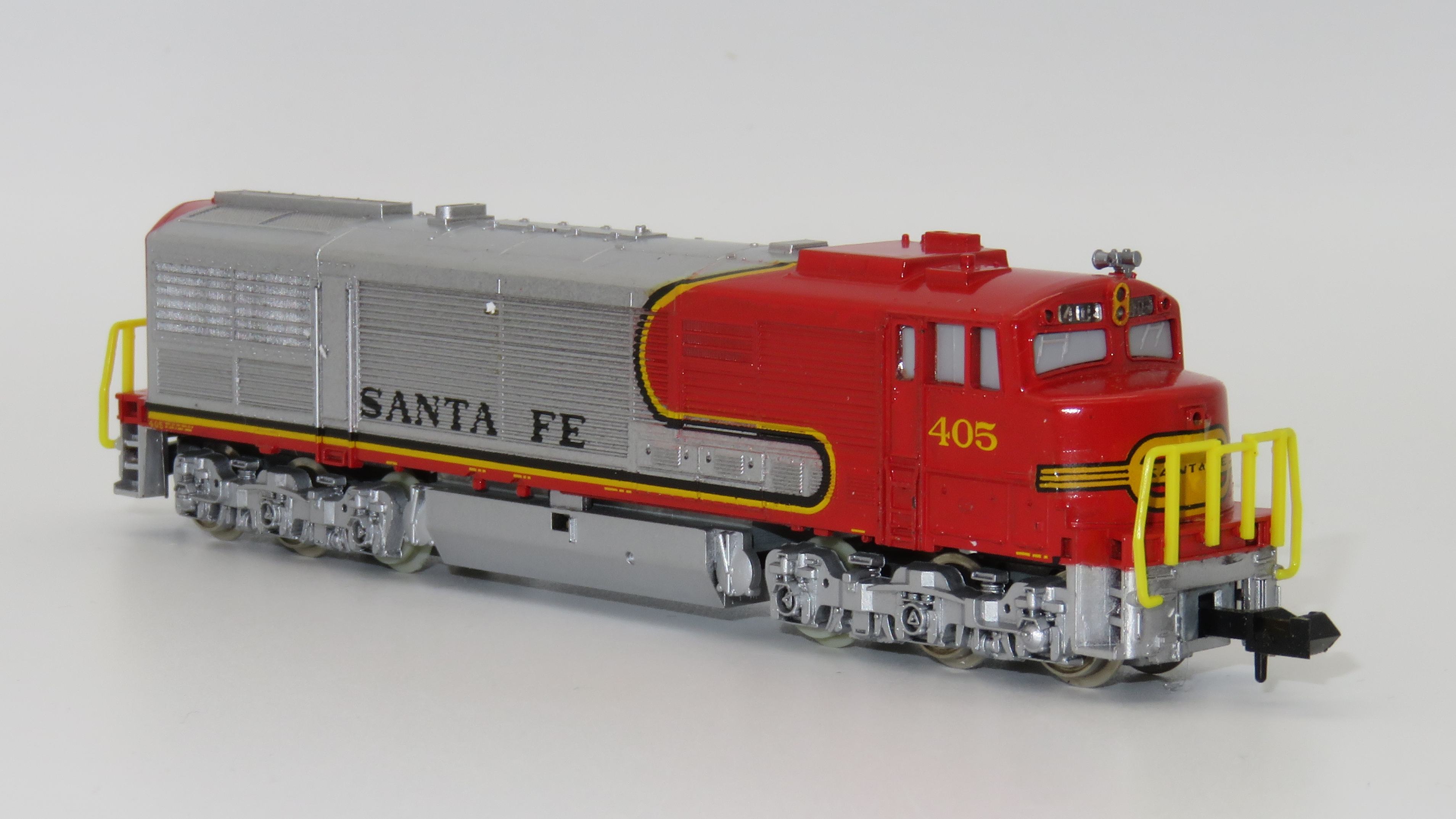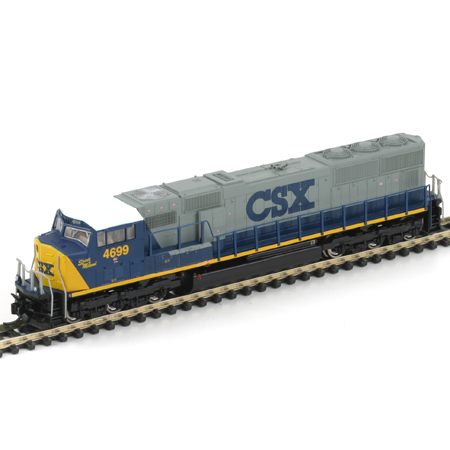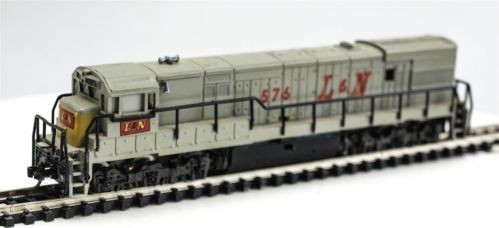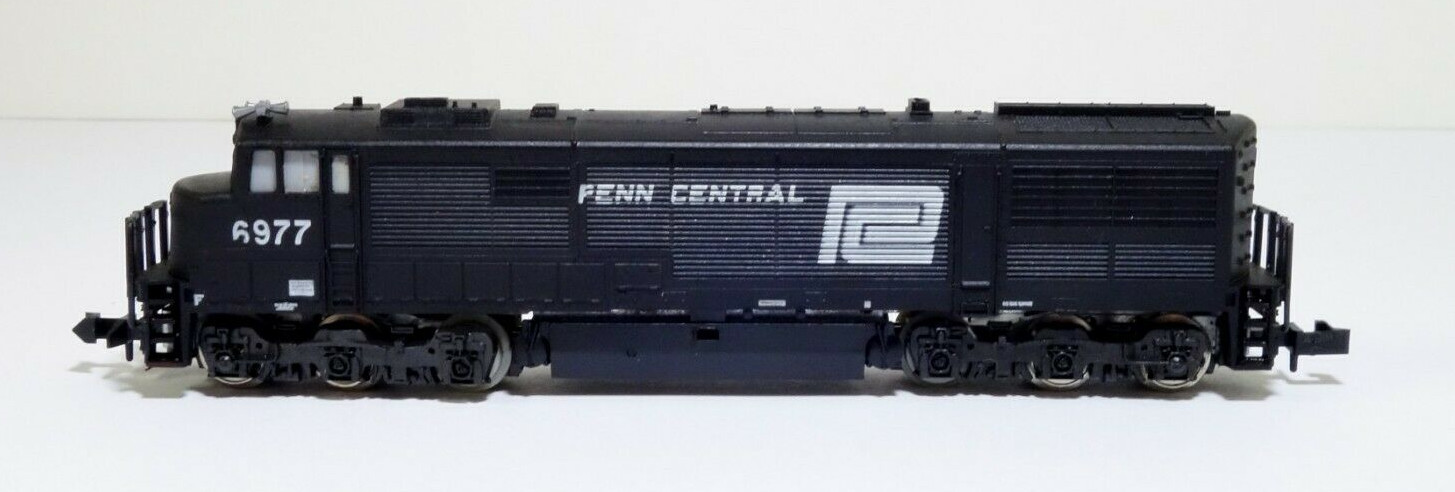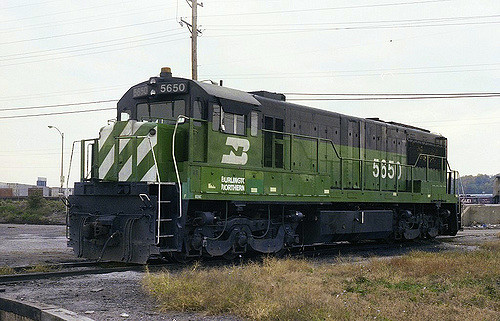Prototype History: The U28C was developed by General Electric from the U25C, with a slight increase in power of 300 hp (224 kW).[2] A passenger-hauling variant, the U28CG, was also produced for the Atchison, Topeka and Santa Fe Railway.
General Electric built ten uprated U25Cs in 1965. Facing the competitive pressure of the second generation horsepower race, GE built these units with increased horsepower. The competitive 2750 horsepower Alco C628 had more horsepower and the 3000 horsepower Alco C630 was announced in July 1965. General Motors had the 3000 horsepower EMD SD40 demonstrators testing on several railroads. The increase in unit horsepower was happening that year. The uprated units were built for three railroads that were already operating the U25C. The first uprated units were built for the Northern Pacific between May and July 1965. These were NP #2518-2520 and were rated at 2750 horsepower. Three more uprated U25Cs were built as Atlantic Coast Line #3011-3013 in December 1965. The ACL units were rated at 2800 horsepower. The last four uprated U25Cs were rated at 2800 horsepower and were built for the Pennsylvania Railroad in December 1965. These were PRR #6516-6519. Six additional PRR U25Cs were uprated to 2800 horsepower: 6500-6503, 6510-6511. In early 1966 General Electric began offering the 2800 horsepower U28C. A total of 28 look-a-like U28Cs were built between February 1966 and July 1966 as Chicago Burlington and Quincy #562-577 and Northern Pacific #2800-2811. These early Phase I U28Cs shared the 64 foot 4 inch frame that was standard with the predecessor U25C.
A drawing of the proposed longer frame U28C is in the November 1965 issue of Trains Magazine. Starting in May 1966 GE began producing the U28C on a longer frame. The new length for these U28Cs was 67 feet 3 inches. These are the 43 Phase II units built for Louisville and Nashville, Pennsylvania, Southern Pacific and Union Pacific. The Phase II units used either the General Electric GT 598 Generator or the GTA 9 Alternator. The 10 Santa Fe U28CGs were also built on this longer frame. Starting in November 1966 and through mid 1967 GE built 24 look a like Phase I U30Cs that used the same carbody as the Phase II U28Cs.
General Electric built ten uprated U25Cs in 1965. Facing the competitive pressure of the second generation horsepower race, GE built these units with increased horsepower. The competitive 2750 horsepower Alco C628 had more horsepower and the 3000 horsepower Alco C630 was announced in July 1965. General Motors had the 3000 horsepower EMD SD40 demonstrators testing on several railroads. The increase in unit horsepower was happening that year. The uprated units were built for three railroads that were already operating the U25C. The first uprated units were built for the Northern Pacific between May and July 1965. These were NP #2518-2520 and were rated at 2750 horsepower. Three more uprated U25Cs were built as Atlantic Coast Line #3011-3013 in December 1965. The ACL units were rated at 2800 horsepower. The last four uprated U25Cs were rated at 2800 horsepower and were built for the Pennsylvania Railroad in December 1965. These were PRR #6516-6519. Six additional PRR U25Cs were uprated to 2800 horsepower: 6500-6503, 6510-6511. In early 1966 General Electric began offering the 2800 horsepower U28C. A total of 28 look-a-like U28Cs were built between February 1966 and July 1966 as Chicago Burlington and Quincy #562-577 and Northern Pacific #2800-2811. These early Phase I U28Cs shared the 64 foot 4 inch frame that was standard with the predecessor U25C.
A drawing of the proposed longer frame U28C is in the November 1965 issue of Trains Magazine. Starting in May 1966 GE began producing the U28C on a longer frame. The new length for these U28Cs was 67 feet 3 inches. These are the 43 Phase II units built for Louisville and Nashville, Pennsylvania, Southern Pacific and Union Pacific. The Phase II units used either the General Electric GT 598 Generator or the GTA 9 Alternator. The 10 Santa Fe U28CGs were also built on this longer frame. Starting in November 1966 and through mid 1967 GE built 24 look a like Phase I U30Cs that used the same carbody as the Phase II U28Cs.
Road Name History: The Atchison, Topeka and Santa Fe Railway (reporting mark ATSF), often abbreviated as Santa Fe or AT&SF, was one of the larger railroads in the United States. Chartered in February 1859, the railroad reached the Kansas-Colorado border in 1873 and Pueblo, Colorado, in 1876. To create a demand for its services, the railroad set up real estate offices and sold farm land from the land grants that it was awarded by Congress. Despite the name, its main line never served Santa Fe, New Mexico, as the terrain was too difficult; the town ultimately was reached by a branch line from Lamy.
The Santa Fe was a pioneer in intermodal freight transport, an enterprise that (at one time or another) included a tugboat fleet and an airline (the short-lived Santa Fe Skyway). Its bus line extended passenger transportation to areas not accessible by rail, and ferryboats on the San Francisco Bay allowed travelers to complete their westward journeys to the Pacific Ocean. The ATSF was the subject of a popular song, Harry Warren & Johnny Mercer's "On the Atchison, Topeka and the Santa Fe", written for the film, The Harvey Girls (1946).
The railroad officially ceased operations on December 31, 1996, when it merged with the Burlington Northern Railroad to form the Burlington Northern & Santa Fe Railway.
Read more on Wikipedia.
The Santa Fe was a pioneer in intermodal freight transport, an enterprise that (at one time or another) included a tugboat fleet and an airline (the short-lived Santa Fe Skyway). Its bus line extended passenger transportation to areas not accessible by rail, and ferryboats on the San Francisco Bay allowed travelers to complete their westward journeys to the Pacific Ocean. The ATSF was the subject of a popular song, Harry Warren & Johnny Mercer's "On the Atchison, Topeka and the Santa Fe", written for the film, The Harvey Girls (1946).
The railroad officially ceased operations on December 31, 1996, when it merged with the Burlington Northern Railroad to form the Burlington Northern & Santa Fe Railway.
Read more on Wikipedia.
Brand/Importer Information: Con-Cor has been in business since 1962. Many things have changed over time as originally they were a complete manufacturing operation in the USA and at one time had upwards of 45 employees. They not only designed the models,but they also built their own molds, did injection molding, painting, printing and packaging on their models.
Currently, most of their manufacturing has been moved overseas and now they import 90% of their products as totally finished goods, or in finished components. They only do some incidental manufacturing today within the USA.
Important Note: The Con-Cor product numbering can be very confusing. Please see here in the article how to properly enter Con-Cor stock numbers in the TroveStar database.
Currently, most of their manufacturing has been moved overseas and now they import 90% of their products as totally finished goods, or in finished components. They only do some incidental manufacturing today within the USA.
Important Note: The Con-Cor product numbering can be very confusing. Please see here in the article how to properly enter Con-Cor stock numbers in the TroveStar database.
Item created by: gdm on 2021-05-13 17:47:01
If you see errors or missing data in this entry, please feel free to log in and edit it. Anyone with a Gmail account can log in instantly.
If you see errors or missing data in this entry, please feel free to log in and edit it. Anyone with a Gmail account can log in instantly.






